Understanding Cat Low Energy and Anorexia: Causes and Solutions
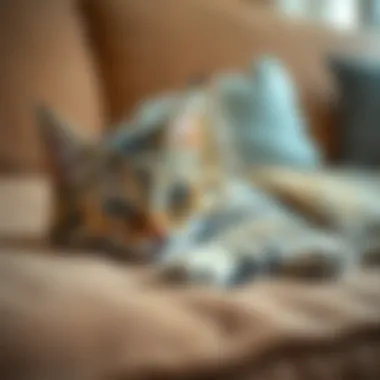
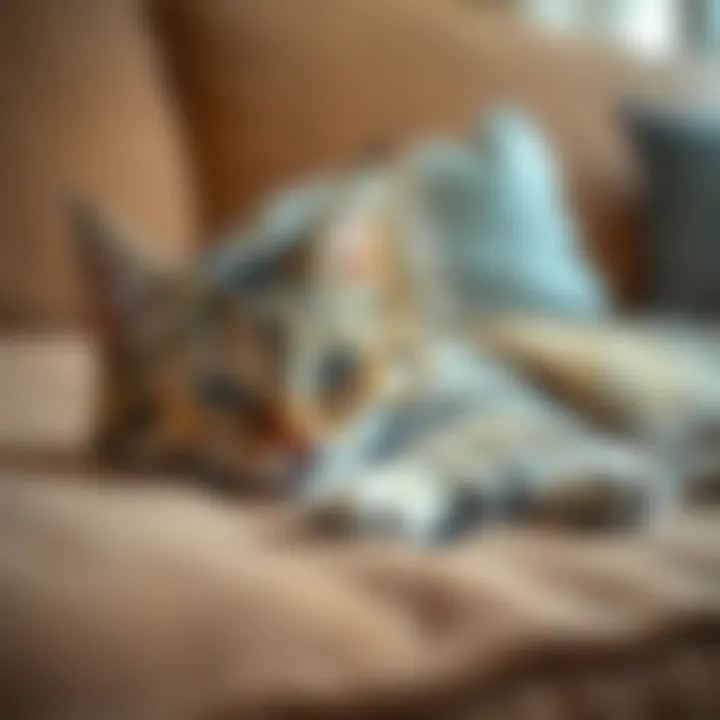
Intro
Cats can be the most spirited companions, but when they start to act sluggish and lose their appetite, it can be a cause for concern. Pet owners often find themselves bewildered when their feline friends suddenly transition from playful to lethargic. It can be as perplexing as trying to untangle a ball of yarn. Understanding the reasons behind low energy and anorexia in cats is crucial for their well-being and may require timely intervention.
Felines are inherently mysterious creatures; their subtle behaviors can hold significant meaning. Whether it’s a hidden health issue, a change in their environment, or even a shift in their daily routine, it's essential to decipher these signs effectively. This article will take you through the maze of potential causes behind low energy and lack of appetite in cats, while also providing actionable solutions to tackle these challenges head-on.
Pet Care Essentials
Caring for a cat isn't just about feeding them and ensuring they have a comfy place to sleep. It's a multi-faceted role that involves attention to their overall health and happiness. Here’s what to focus on:
Daily Nutrition Requirements
A well-balanced diet is crucial for your cat's vitality. Cats are obligate carnivores, meaning they require a diet rich in animal proteins. Selecting a high-quality cat food that fits their needs is essential. Look for:
- Balanced proteins: Ensure meat is the first ingredient on the label.
- Added nutrients: Ingredients like taurine and omega fatty acids support overall health.
- Hydration: Don't forget to offer fresh water daily; hydration is key.
Exercise and Playtime
Don't let your cat become a couch potato. Regular exercise not only keeps them fit but also stimulates their mind. Rotate their toys frequently to keep things interesting. A few effective methods include:
- Interactive toys: Laser pointers, feather wands, or automated toys can keep them engaged.
- Cat trees: Climbing structures can promote physical activity while satisfying their natural instincts.
Grooming Tips
Part of caring for your feline is maintaining their coat health. Regular grooming can help prevent matting and also provides an opportunity to check for any skin issues. Depending on your cat’s breed, the frequency of grooming might vary:
- Short-haired cats: May require less frequent grooming than long-haired breeds, but brushing once a week helps.
- Long-haired cats: Aim for every couple of days to keep tangles at bay.
Health and Wellness Check-ins
Routine vet visits should form the backbone of any pet care plan. Regular check-ups help catch any underlying health issues before they escalate. Key things to monitor include:
- Weight: Sudden changes can be telling of nutritional imbalances or illness.
- Behavioral changes: Loss of appetite should trigger a conversation with your vet.
- Vaccinations and preventative treatments: Keep schedules up-to-date to avoid preventable diseases.
Behavior & Training
Understanding your cat's behavior can often lead to early identification of health issues. An observant owner knows that changes in behavior might indicate something is amiss, causing low energy or anorexia.
Understanding Your Pet's Body Language
Cats communicate much through body language. Signs of distress or discomfort can include:
- Ears backward
- Tail twitching
- Withdrawal or hiding
Recognizing these signs can help you address problems before they escalate.
Basic Training Techniques
Basic training can ease stress in your cat, leading to better behavior and social skills. Simple commands or litter box training can be achieved with consistency and positive reinforcement.
Behavioral Concerns & Solutions
If your cat demonstrates excessive lethargy or avoidance of food, consider whether stressors in their environment, such as moving to a new home or the arrival of another pet, could be affecting them. Creating a calming routine may ease their anxiety.
Socialization Tips
Cats are not as social as dogs, but they definitely thrive on interaction. Gentle introductions to new people or pets can help avoid any unnecessary stress.
"Recognizing changes in a pet's behavior can save their home and health."
Pet Home Environment
Creating a safe and stimulating environment is critical to a happy cat. Factors in their surroundings can send them into a funk, hence the importance of evaluating their habitat.
Creating a Pet-friendly Space
Ensure that your home is enriched for their natural behaviors which include:
- Climbing opportunities: Cat trees or shelves enable them to explore vertically.
- Quiet resting spots: High-quality beds in quiet areas give them a place to retreat.
Safety Measures and Hazards to Avoid
A happy home for your feline is one that is safe. Be wary of:
- Toxic plants: Keep harmful plants, like lilies, out of reach.
- Small objects: Items like rubber bands or yarn can be choking hazards.
Choosing the Right Toys and Accessories
Investing in good quality toys can promote mental stimulation and prevent boredom. Opt for:
- Puzzle toys: Encourage problem-solving while offering treats.
- Soft toys: To provide a comforting presence.
Setting Up a Comfortable Resting Area
A serene space for your cat to retreat is integral. Cats tend to seek privacy and warmth. Choose an area that offers:
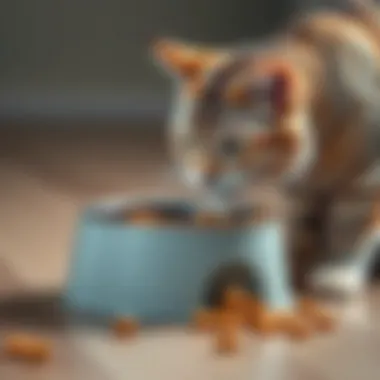
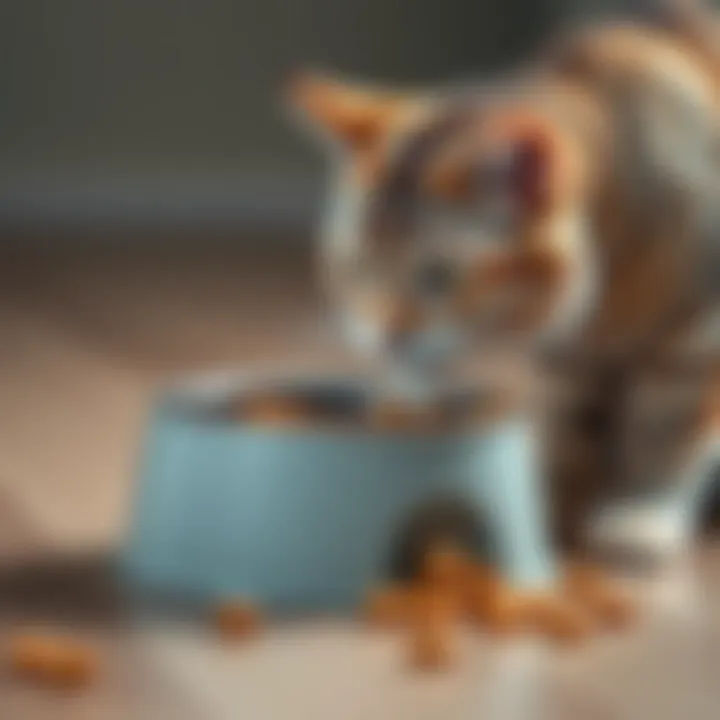
- Quietness: Away from high-traffic areas.
- Warmth: A cozy blanket can create the perfect snuggly spot.
Pet Health Issues
Being aware of potential health problems is foundational in understanding why a once lively cat may become lethargic or lose their appetite.
Recognizing Signs of Illness
Pay attention to common indicators:
- Weight loss
- Changes in grooming habits
- Diarrhea or vomiting
Addressing health concerns early can be life-saving.
Preventative Care Measures
Keeping your cat on a regular healthcare routine can avert serious issues:
- Vaccinations: Ensure they're up to date with all necessary shots.
- Scheduled vet visits: At least once a year, or as recommended by your vet.
Common Ailments and Treatments
Several health issues can cause lethargy and loss of appetite:
- Dental disease: Can cause pain and lead to decreased eating.
- Kidney disease: Common in older cats requiring ongoing treatment.
Emergency Preparedness
Have a plan ready if your cat shows signs of severe illness. Know the nearest emergency vet's address and keep their contact information handy.
Your cat's well-being is paramount, and recognizing early signs of low energy and anorexia can help you give them the care they need. Be proactive and always seek professional advice when needed.
Preface to Low Energy and Anorexia in Cats
Understanding low energy and anorexia in cats is crucial for anyone who cares for these beloved companions. Cats are known for their playful and curious nature, but when they become lethargic and show a reluctance to eat, it can be a cause for concern. These symptoms can indicate underlying health issues that require attention, and if left untreated, can lead to serious or even life-threatening conditions.
When addressing low energy, it’s not just about noticing that your cat isn't as active as usual; it’s about understanding the multifaceted aspects contributing to their behavior. Perhaps they have been feeling under the weather, or maybe there's an environmental factor at play. As pet owners, recognizing the early signs of distress in our feline friends can make a world of difference.
Anorexia in cats is equally important to grasp—it's not merely a loss of appetite, but rather a significant health signal. A cat who refuses to eat not only faces the risk of nutritional deficiencies but also issues that could compromise its entire well-being. Knowledge of why a cat may eat less can equip owners with the insight needed to act swiftly, tackling the issue before it spirals out of control.
By learning about these conditions, pet owners can prioritize timely veterinary care and adapt their approaches to meet their cats' needs. This article aims to explore various causes of low energy and anorexia, delve into the behavioral, environmental, and health-related factors affecting cats, and provide actionable solutions to support their recovery and health—all while building a deeper understanding of the unique needs of these majestic creatures.
Remember: Early intervention often leads to better outcomes, so being informed is your first line of defense.
Identifying Symptoms and Indicators
Recognizing when your cat is under the weather requires a keen eye. It’s not like these furry pals come with a manual. They can’t tell you about their discomfort or change in appetite, which is why understanding the symptoms and indicators of low energy and anorexia is crucial. These signs often point to deeper health issues—catching them early can be the difference between a swift recovery and a more serious medical scenario. Being vigilant about your cat’s behavior allows you to approach any concerns proactively, rather than waiting until things have escalated out of control.
Physical Signs of Low Energy
Low energy in cats can manifest in various physical signs. If your usually sprightly feline has taken to lounging around more than normal, it’s time to pay attention. Here are a few indicators that may reveal underlying issues:
- Reduced Activity Levels: If your cat usually bounces around the house, but now prefers to stay curled up on the sofa, this could be a red flag. Check if there are favorite toys they no longer seem interested in.
- Lethargy: It’s normal for cats to spend a lot of time napping, but excessive lethargy that appears out of the blue can be a cause for concern.
- Changes in Grooming: Cats are known for their meticulous grooming habits. A sudden decline in grooming could indicate an energy deficit or discomfort. You might notice a dull coat or even some unkempt patches.
- Weight Loss: If your cat is looking a bit too svelte, keep a record of their weight. Unintentional weight loss can often accompany low energy and anorexia.
Being observant about these signs can help you determine whether your cat requires a trip to the vet. As they say, "an ounce of prevention is worth a pound of cure."
Behavioral Changes to Note
Behavior goes hand in hand with physical signs. A cat’s demeanor can speak volumes about their wellbeing. Changes in behavior can often be seen alongside low energy and may include:
- Social Withdrawal: Is your cat becoming more of a recluse? A previously sociable kitty might retreat to solitude, avoiding interaction with you or other pets. This can indicate emotional distress or discomfort.
- Altered Eating Habits: Decreased interest in food is one of the most striking signs of anorexia. If your cat used to be a keen eater and is now turning up their nose at meals, it’s essential to investigate further.
- Increased Aggression or Irritability: Sometimes, discomfort can manifest as irritability. If your feline friend snaps at you when you approach or is less tolerant of other pets, it may be an indication they are feeling unwell.
- Vocal Changes: Unusual vocalizations, whether it’s excessive yowling or sudden silence, could indicate pain or distress.
In short, changes in behavior may reveal the emotional and physical state of your feline companion. Just like we humans can become cranky when we're not feeling well, cats can also express their discomfort through behavior. Keep a watchful eye on these indicators; they can provide vital clues to better understand your cat's condition and ensure they receive the attention they might need.
Common Health Issues Leading to These Symptoms
When a cat experiences low energy and anorexia, it often signals underlying health concerns. Understanding these common health issues is crucial for pet owners, as they can lead to serious complications if left unaddressed. The aim here is to shed light on the most prevalent health issues that contribute to these symptoms, thereby providing a clearer path for both diagnosis and treatment. Being aware of these conditions not only empowers cat owners to make informed decisions but also enhances their role in their pets' well-being.
Chronic Illnesses
Chronic illnesses can severely affect a cat's overall health, altering energy levels and appetite. Two of the most noteworthy conditions are kidney disease and hyperthyroidism.
Kidney Disease
Kidney disease is particularly prevalent in older cats. As the kidneys deteriorate, they become less efficient at filtering toxins from the bloodstream. This decreased function can lead to several symptoms, one of which is a noticeable drop in energy. A key characteristic of kidney disease is the cat's tendency to drink excessive amounts of water, often accompanied by increased urination. This is due to the body's attempt to flush out toxins that cannot be effectively eliminated.
The significance of recognizing kidney disease is immense. Timely diagnosis can lead to management strategies that could potentially prolong the cat's quality of life. One unique feature of kidney disease is its gradual onset, sometimes making it difficult for owners to pinpoint the exact moment something is wrong.
However, a disadvantage is that once the disease progresses, it may lead to irreversible damage. Thus, regular veterinary check-ups are essential for early detection.
Hyperthyroidism
Hyperthyroidism is another chronic condition affecting older cats. It's caused by an overproduction of thyroid hormones, which can lead to increased metabolism, thus hunting for food and resulting in weight loss despite a ravenous appetite. This can create a paradox where the cat seems hungry yet is losing weight, often leading to further anorexia as some cats become fatigued from their body's overactivity.
This condition can often be managed through medication, dietary changes, or even surgical options. Its primary advantage is that, while serious, hyperthyroidism is treatable, allowing many cats to return to a more normal lifestyle. However, neglecting this condition can lead to severe consequences, including heart issues and, in some cases, death.
Infectious Diseases
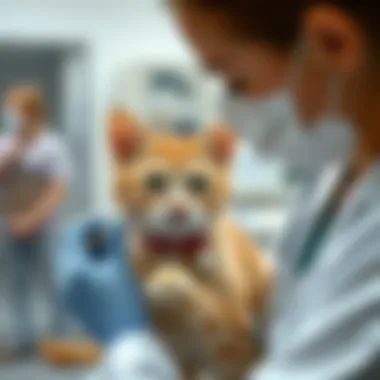
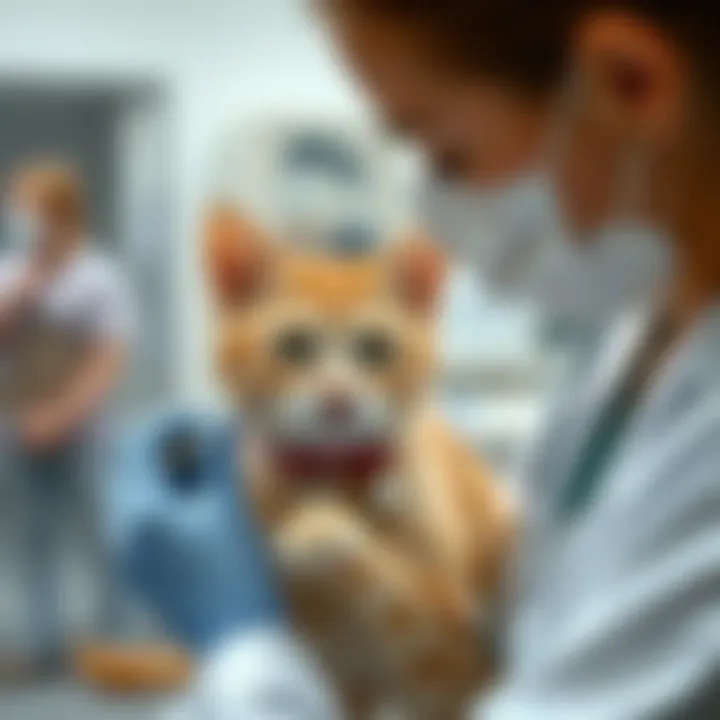
Infectious diseases are another area of concern that can lead to lethargy and reduced appetite in cats. Feline leukemia and feline immunodeficiency virus are two serious infections that cat owners should be aware of.
Feline Leukemia
Feline leukemia is a viral infection that profoundly impacts a cat's immune system. Since the virus interferes with the immune response, cats become more susceptible to other infections, which may cause lethargy and poor appetite. A crucial characteristic of feline leukemia is that it often remains undetected until it’s too late because many infected cats can seem healthy for a long while.
The benefit of recognizing feline leukemia lies in early testing and vaccination strategies that can protect other cats in a multi-pet household. However, if a cat is diagnosed late, the prognosis can be dire, leading to various complications, including cancers and secondary infections.
Feline Immunodeficiency Virus
Feline immunodeficiency virus, often called FIV, is another virus that compromises the immune system over time. Like feline leukemia, it can lead to chronic infections, thus producing low energy levels and decreased appetite. A key detail about FIV is how it spreads; FIV is contracted primarily through bite wounds, making outdoor exposure and fights with other cats a significant risk.
For this article, understanding FIV is beneficial as it underscores the importance of responsible pet ownership, including spaying or neutering and keeping cats indoors to minimize contact with potentially infected cats. One drawback, however, is that once FIV is contracted, though many cats live long lives without showing symptoms, the long-term implications for their health can be serious.
Digestive Disorders
Digestive disorders can also be culprits in causing low energy and anorexia. From gastrointestinal issues to food allergies, the gut plays a critical role in a cat's well-being.
Gastrointestinal Issues
Gastrointestinal issues encompass a broad range of conditions, including inflammatory bowel disease and infections, which can lead to nausea and lack of appetite. A notable characteristic of these conditions is visible discomfort from the cat, manifested in behaviors like hiding or reduced activity.
Recognizing this is crucial, as dietary adjustments and medication can often manage these issues. The advantage of understanding gastrointestinal disorders lies in their potential reversibility with proper care. However, neglecting these symptoms can lead to severe dehydration or malnutrition over time.
Food Allergies
Food allergies in cats can lead to various health issues, including vomiting and diarrhea, which can contribute to lethargy and a significant loss of appetite. A common hallmark is that the symptoms often persist or worsen despite following a standard diet.
Identifying food allergies is beneficial because, once identified, changing a cat’s diet could drastically improve health and quality of life. The drawback is that it often involves trial-and-error approaches which can be exhausting and costly for pet owners.
Understanding and recognizing these health issues leading to low energy and anorexia is critical for timely intervention. When cat owners are informed, they become better equipped to advocate for their pets' health.
Behavioral Factors Influencing Energy and Appetite
When it comes to insightful understanding of cat health, behavioral factors play a pivotal role in influencing both energy levels and appetite in our feline companions. Examining this aspect not only sheds light on specific conditions but also on holistic solutions that cat owners can implement to enhance their pets’ well-being. Not every case of low energy or decreased appetite can be traced back to physical maladies; oftentimes, emotional or environmental factors lie at the heart of the issue.
Stress and Anxiety
Stress and anxiety in cats are not just fleeting feelings—they're significant concerns that can affect their overall health. Just like people, cats can feel overwhelmed by changes in their surroundings or routine. For instance, a move to a new home, the introduction of a new pet or family member, or even changes in the owner's behavior can spark stress in cats.
The Signs of Stress:
When a cat is stressed, it often manifests in subtle behaviors that owners need to recognize early. These can include:
- Excessive grooming or hiding
- Marking territory inappropriately
- Changes in sleeping patterns
- Decreased interaction with owners or other pets
In more severe cases, a stressed cat may withdraw from social engagement and decline to eat—this is where the relationship between anxiety and anorexia becomes evident. As anxious furballs tend to lose their appetite, they could spiral into a frustrating cycle of low energy exacerbated by a lack of nutrition.
"Understanding the emotional landscape of your cat can be just as critical as knowing their physical health."
Changes in Environment
Environment profoundly influences a cat's behavior and can lead to changes in energy and appetite. Cats are creatures of habit, and any shift in their environment—from a new piece of furniture to an entirely new home—can unsettle them. Consider how an open floor plan might make a once spacious territory feel exposed or how the presence of new smells might make them feel encroached upon.
Concrete Instances of Environmental Changes:
- New pets moving into the household may lead to competition for resources, making cats feel more anxious.
- Relocating furniture can interfere with a cat's sense of security.
- Changes in routine, like differing feeding times or alterations in family schedules, can cause unpredictable stress.
As owners, it’s key to manage these changes sensitively. Gradual introductions to new environments or altered routines can help ease the transition for your cat. Keeping their schedules consistent and ensuring they have safe, quiet spaces to retreat to will work wonders in keeping their energy up and their appetite steady.
By paying attention to these behavioral factors, pet owners can make necessary adjustments to mitigate their cats’ stress and well-being, leading to an overall improvement in their energy levels and appetite.
Dietary Considerations
Understanding how dietary choices impact a cat's energy and appetite is crucial for any cat owner. There's an old saying that you are what you eat, and it rings true for our feline friends as well. Inadequate or imbalanced nutrition can lead to a decline in health, manifesting as low energy levels and even anorexia. Therefore, addressing dietary considerations is not a mere suggestion; it's an essential component of ensuring an optimal quality of life for your pet.
Importance of Nutrition
When we speak about nutrition, it’s more than just filling a bowl with kibble. Cats are obligate carnivores, meaning their bodies are designed to thrive on a diet rich in meat. This dietary necessity translates to specific protein requirements that differ from other pets. If a cat's diet lacks the right balance of proteins, vitamins, and minerals, it can easily become lethargic. Here are some key points to remember:
- High-quality protein: Cats require a significant amount of protein in their diet for energy. It helps in muscle maintenance and metabolic functions. Think fish, chicken, or turkey.
- Essential vitamins and minerals: Nutrients like taurine, arginine, and essential fatty acids are important for a cat's overall health, affecting everything from heart function to energy levels.
- Hydration needs: Cats often do not drink enough water. Insufficient hydration can lead to kidney problems, further exacerbating energy levels and appetite. Incorporating wet food can help keep your cat hydrated.
Additionally, monitoring a cat's weight can serve as a gauge for their nutritional intake. If a cat begins to lose weight, this could be an indicator that their diet isn't meeting their needs.
Identifying Nutritional Deficiencies
Pinpointing nutritional deficiencies is key to preventing low energy and lack of appetite in your cat. Recognizing signs is a combination of observation and knowledge. Furthermore, it’s worth noting that these deficiencies often don’t spring up overnight. More commonly, they are a slow boil, taking shape over time.
Some signs you might notice include:
- Lethargy: A cat that usually zips around might slow down due to insufficient energy from their diet.
- Dull fur: A coat that's typically glossy may turn dull and unkept if essential fatty acids are lacking.
- Weight loss: This can indicate that a cat is not receiving the necessary calories or nutrients, prompting you to review their diet.
To ensure your cat is getting what they need, consider:
- Regular vet check-ups: Annual or bi-annual veterinary evaluations can help identify any underlying deficiencies before they escalate.
- Dietary adjustments: Consult with your veterinarian or a pet nutritionist to create a balanced diet based on your cat’s specific needs, age, and health status.
- Supplementation: Sometimes, adding specific supplements can address deficiencies. Again, it’s important to consult a professional before making any changes.
"A balanced diet can be the thin line between a playful cat and one that sleeps away the day."
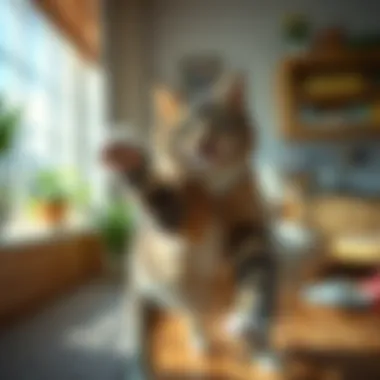
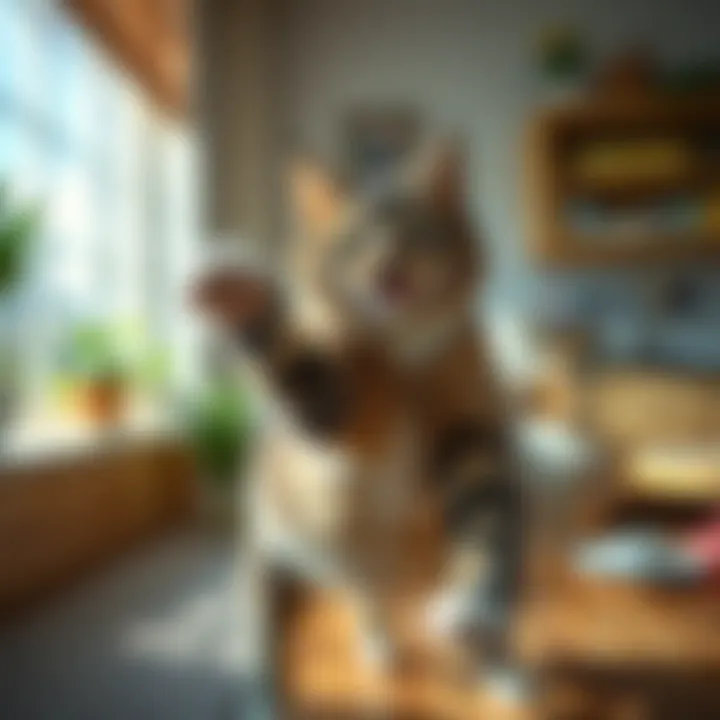
When to Seek Veterinary Help
When your feline companion is experiencing low energy and anorexia, it can be a heart-wrenching sight for any pet owner. These symptoms may not only indicate something minor, like a temporary fussy phase, but could also be signs of serious health issues. Recognizing when to seek veterinary assistance is crucial for safeguarding your pet’s health and well-being.
Determining Severity of Symptoms
As a careful cat owner, you should attentively observe your cat's behavior. Not all signs are overly dramatic. A subtle shift in your cat's activity level or eating habits can mean a lot. Here are some factors that can help gauge the severity:
- Duration: If your cat shows low energy or refusal to eat for more than 24 hours, it’s time to pick up the phone.
- Accompanying Symptoms: Are there other symptoms like vomiting, diarrhea, or changes in litter box habits? These can indicate a more serious condition.
- Underlying Health Issues: If your furry friend has previous medical conditions, even a slight decline in energy should set off alarm bells.
"Never hesitate to consult your vet; your cat may be relying on you to secure their health and happiness."
Types of Veterinary Tests
Once at the veterinary clinic, a variety of diagnostic tools can determine the cause of low energy and anorexia. Understanding these tests gives insights into your cat's health status.
Blood Tests
Blood tests are among the first lines of investigation. They can reveal crucial information about your cat's internal health. These tests check hormone levels, organ functions, and even infections. They are a common choice for several reasons:
- Key Characteristic: They can quickly show abnormalities in blood cells and biochemical markers, making them a beneficial option for assessing overall health.
- Unique Feature: The turnaround time for results is relatively fast. Within hours, you may have a clearer picture of what’s going on with your cat's health.
- Advantages/Disadvantages: While blood tests provide vital information, they can sometimes lead to further testing if results are not clear-cut. This can be a double-edged sword, as it may add to stress and costs.
Ultrasound
An ultrasound is another tool often utilized in broader diagnostic processes. It uses sound waves to create images of the internal structures of your cat's body. Here’s what you need to know:
- Key Characteristic: The scan can provide real-time information about organs such as the liver and kidneys.
- Beneficial Choice: It’s particularly useful for identifying tumors or collect fluid samples, often necessitated when blood tests reveal irregularities.
- Unique Feature: Unlike X-rays, ultrasounds can show soft tissue conditions that other imaging might miss.
- Advantages/Disadvantages: Though non-invasive, ultrasounds do require sedation in some cases, which could pose additional risks, particularly for a cat with health issues.
Treatment Options for Affected Cats
When cats present with low energy and loss of appetite, addressing these symptoms involves a multifaceted approach. Treatments vary considerably depending on the underlying causes, but it's crucial for pet owners to be well-informed about the options available. Timely interventions can make a significant difference in restoring a cat's health and overall well-being.
Medical Interventions
Medications
Medications play an essential role in managing low energy and anorexia in cats. These can include pain relievers, anti-nausea drugs, and antibiotics that tackle specific underlying health issues. A key aspect of medications is their ability to target immediate health problems, ultimately promoting recovery. Common choices like metoclopramide can help stimulate the digestive tract, making it easier for cats to eat and absorb nutrients.
However, relying solely on medications can have downsides. Some cats may experience side effects or have reactions to certain drugs, making consultation with a veterinarian essential to tailor treatments effectively. The unique feature of using medication is its potential to provide rapid relief, but it is often complemented by other treatment forms, ensuring a well-rounded approach.
Appetite Stimulants
When cats are not eating, appetite stimulants come to the rescue. Drugs like mirtazapine are among the options available for veterinary use. The primary goal of appetite stimulants is to encourage feeding by altering the cat's brain chemistry, thus making food more appealing. These are popular choices for cats facing severe anorexia, primarily because they can motivate pets to eat again, which is crucial for their recovery.
The charm of using appetite stimulants lies in their rapid effects, encouraging cats to consume food within a matter of hours. While they can be beneficial, it's worth mentioning that these stimulants may not address the root cause of anorexia, which makes follow-up assessments vital.
Nutritional Adjustments
Changing a cat's diet can sometimes be as effective as medication. Specialized diets designed for specific health conditions, such as kidney disease or gastrointestinal issues, can provide essential nutrients in a way that’s easier for an affected cat to digest. Ensuring that a cat receives enough caloric intake, even when they are picky eaters, often involves experimenting with various food textures and flavors.
For instance, canned food is more palatable due to its stronger scent compared to dry kibble. Furthermore, warmth can enhance aroma and taste, stimulating a cat's interest in food.
Behavioral Therapy
Behavioral methods can complement medical and nutritional interventions. Stress-relief techniques may include creating a serene feeding environment, helping it to feel safe while eating. Adjustments could involve changing the type of feeding dish, location, or even the time at which meals are served. Making mealtime a low-pressure occasion can reduce anxiety and encourage eating. Consulting a feline behaviorist could provide tailored strategies that resonate specifically with your cat’s personality and environment.
Regular check-ups are vital. Monitoring both health and behavioral changes can guide adjustments to the treatment plan, placing emphasis on the notion that chronic low energy and anorexia can point to larger health concerns.
Preventive Measures for Cat Owners
Addressing low energy and anorexia in cats can be a daunting task for any pet owner. However, the best strategy often lies in prevention. By taking proactive steps, owners can create an environment that supports their feline companions both physically and emotionally. Here are some critical measures every cat owner should consider:
A stitch in time saves nine. Keeping an eye on your cat now can prevent bigger problems later.
Establishing a Routine
Creating a routine can work wonders for a cat's mental and physical health. Cats, by nature, are creatures of habit. They thrive on predictability and consistency. A daily schedule that includes feeding times, playtime, and even quiet time can help to stabilize a cat's energy levels and appetite.
- Feeding Schedule: Try to feed your cat at the same times each day. This not only helps in regulating their hunger signals but also allows you to notice any changes in eating behavior promptly.
- Playtime Routine: Engage in regular play sessions; aim for at least thirty minutes a day. Interactive toys or laser pointers can stimulate their instincts and encourage movement, helping to combat lethargy.
- Rest and Relaxation: Cats also need their downtime, and having a quiet corner can help them recharge. Ensure there are various cozy spots around the house where they feel comfortable and safe.
Monitoring Health Regularly
Regular health monitoring for your cat is another fundamental preventive measure. Just like humans, cats can experience subtle changes in their health that owners might overlook. Establishing a protocol for checking on your cat's health can help catch issues before they escalate.
- Observe Behavioral Changes: Pay attention to changes in their behavior, appetite, and energy levels. If Fluffy opts to snooze through playtime or leaves food untouched, it may be time to take a closer look.
- Routine Vet Check-ups: Schedule regular veterinary visits at least once a year. These visits are essential for preventive care, including vaccinations and general health assessments.
- Weight Checks: Keep an eye on your cat's weight. A sudden increase or drop can signal underlying health issues and should be addressed promptly.
In summary, preventive measures play a vital role in maintaining your cat's overall health and well-being. Establishing a routine and monitoring health regularly can not only make noticeable differences but also foster a strong bond between you and your pet. Don't wait for the warning signs to appear; taking these steps now can pave the way for a healthier, happier feline life.
For additional insights on caring for your cat, you might find these resources helpful:
- The Humane Society: Caring for Your Cat
- American Veterinary Medical Association
- PetMD: Behavioral Health in Cats
Culmination
In wrapping up the discussion on cat low energy and anorexia, it’s evident that these symptoms often mask deeper health issues and emotional struggles. Understanding the underlying causes not only aids in proper diagnosis but also forms the groundwork for effective treatment strategies. For cat owners, recognizing the subtle shifts in behavior and energy levels is your first line of defense against more serious health concerns.
The Importance of Holistic Care
A thorough approach in managing your cat’s health is pivotal. Holistic care doesn’t merely focus on treating the symptoms but views the cat as a whole. This includes considering factors like environment, nutrition, and emotional well-being.
- Physical Health: Regular veterinary check-ups are crucial to identify any potential ailments before they escalate. This proactive approach ensures that issues are addressed in a timely manner.
- Dietary Needs: A cat’s diet plays a significant role in its energy levels and overall health. Tailoring a nutritional plan specific to your cat's needs will support its well-being.
- Mental Health: Just as important is your cat’s emotional state. Stressors such as changes in the household or lack of stimulation can lead to decreased energy and appetite. Providing a stable, enriched environment can help alleviate some of these pressures.
"A well-rounded approach not only helps in treating immediate concerns but fosters long-term wellness for our feline friends."







